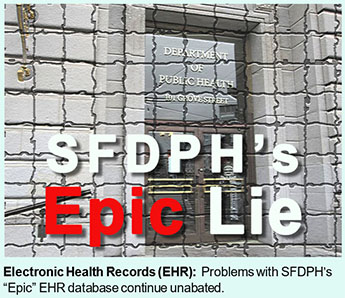 August 17, 2022
August 17, 2022Epic Part 3: More Laguna Honda Hospital Problems
City’s Useless Health Department “Epic” Database
 August 17, 2022
August 17, 2022
Epic Part 3: More Laguna Honda Hospital Problems
City’s Useless Health Department “Epic” Database
Potential Good News: August 8, 2022
LHH Pausing License Change to Remove 120 Beds
Great News: August 15, 2022
CMS Extending Medicare Payments to LHH and Extending Closure Date,
From September 13 to November 13, 2022
Bad News: “Epic” Database Continuing Problems and
LHH’s Missing-in-Action “Restorative Care” Program
by Patrick Monette-Shaw
Before reporting additional problems involving the San Francisco Department of Public Health’s $164 million database named “Epic” that is affecting patients being discharged from Laguna Honda Hospital (LHH), let me present some quick status updates on issues the Westside Observer has covered during the past several months on the potential closure of LHH.
Summary of Recent Developments
A number of developments have surfaced since the Westside Observer published several articles on August 1 indicating that the discharges of LHH residents have been temporarily “paused.” The developments include:
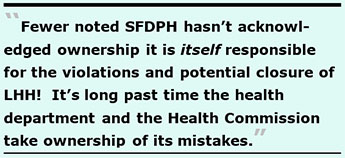 Fewer is absolutely correct, just as she so often was when she served on San Francisco’s Board of Supervisors: SFDPH and our Health Commission have downplayed even before mid-April when the potential closure of LHH was announced that the severity of patient care violations that occurred at LHH between October 14, 2021 and April 14, 2022 were due to mistakes SFDPH staff had made over a long, long time. Fewer noted that SFDPH hasn’t acknowledged ownership that it is itself responsible for the violations and potential closure of LHH! It’s long past time the health department and the Health Commission take ownership of its mistakes.
Fewer is absolutely correct, just as she so often was when she served on San Francisco’s Board of Supervisors: SFDPH and our Health Commission have downplayed even before mid-April when the potential closure of LHH was announced that the severity of patient care violations that occurred at LHH between October 14, 2021 and April 14, 2022 were due to mistakes SFDPH staff had made over a long, long time. Fewer noted that SFDPH hasn’t acknowledged ownership that it is itself responsible for the violations and potential closure of LHH! It’s long past time the health department and the Health Commission take ownership of its mistakes. 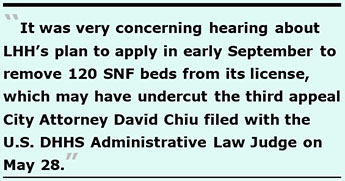 from 769 to 649 beds was 66% complete and was anticipated to be completed by August 19, 2022. An Environmental Services team had been working to clean the de-occupied patient spaces.
from 769 to 649 beds was 66% complete and was anticipated to be completed by August 19, 2022. An Environmental Services team had been working to clean the de-occupied patient spaces.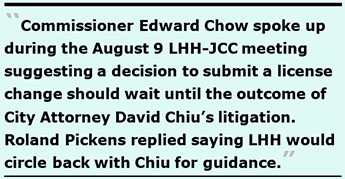 Luckily, Commissioner Edward Chow spoke up during the August 9 LHH-JCC meeting, suggesting LHH’s management team halt all major decisions involving LHH, wait until the conclusion of City Attorney David Chiu’s and Ms. Renne’s two Federal lawsuits, and wait for the outcome of Chiu’s three appeals pending before the U.S. DHHS Administrative Law Judge. Hopefully, if CMS’ decertification of LHH is overturned, that may negate having to cut 120 beds, keep LHH from having to discharge all of its current residents, and prevent LHH from having to apply for recertification. LHH’s acting CEO, Roland Pickens replied to Dr. Chow saying the hospital would circle back with Chiu’s office to see if the hospital could postpone changing its license until later in the potential closure process. The community and the Board of Supervisors will need to continue monitoring this issue.
Luckily, Commissioner Edward Chow spoke up during the August 9 LHH-JCC meeting, suggesting LHH’s management team halt all major decisions involving LHH, wait until the conclusion of City Attorney David Chiu’s and Ms. Renne’s two Federal lawsuits, and wait for the outcome of Chiu’s three appeals pending before the U.S. DHHS Administrative Law Judge. Hopefully, if CMS’ decertification of LHH is overturned, that may negate having to cut 120 beds, keep LHH from having to discharge all of its current residents, and prevent LHH from having to apply for recertification. LHH’s acting CEO, Roland Pickens replied to Dr. Chow saying the hospital would circle back with Chiu’s office to see if the hospital could postpone changing its license until later in the potential closure process. The community and the Board of Supervisors will need to continue monitoring this issue.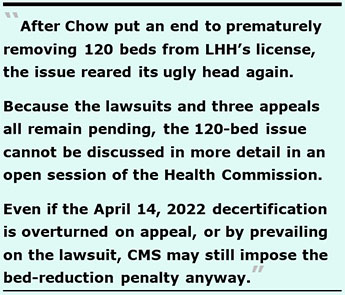 I Spoke Too Soon … on the 120 Beds Just a week after it sounded like Chow had put an end to prematurely changing LHH’s license to remove the 120 beds from its license, the issue reared its ugly head again.
I Spoke Too Soon … on the 120 Beds Just a week after it sounded like Chow had put an end to prematurely changing LHH’s license to remove the 120 beds from its license, the issue reared its ugly head again.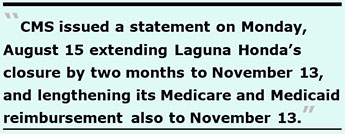 CMS Extended LHH’s Closure Date and Extended Medicare Payments to LHH As a result of the federal lawsuit filed by City Attorney David Chiu and Chiu’s three administrative appeals to a U.S. DHHS Administrative Law Judge, CMS issued a joint statement on Monday, August 15 extending the date of Laguna Honda’s closure by two months — from September 13 to November 13, 2022 — and lengthening LHH’s Medicare and Medicaid reimbursement also to November 13.
CMS Extended LHH’s Closure Date and Extended Medicare Payments to LHH As a result of the federal lawsuit filed by City Attorney David Chiu and Chiu’s three administrative appeals to a U.S. DHHS Administrative Law Judge, CMS issued a joint statement on Monday, August 15 extending the date of Laguna Honda’s closure by two months — from September 13 to November 13, 2022 — and lengthening LHH’s Medicare and Medicaid reimbursement also to November 13.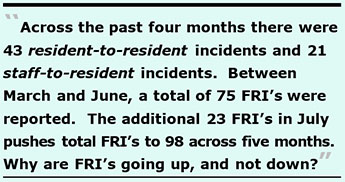 LHH’s Facility-Reported Incidents (FRI’s) Continue Unabated Sadly, the LHH-JCC Regulatory Affairs Report for July 2022 presented on August 9 reported LHH racked up another 23 Facility Reported Incidents (FRI’s) in July alone, while CMS is breathing down LHH’s management and nursing leadership’s necks as LHH continues fighting to regain its CMS certification.
LHH’s Facility-Reported Incidents (FRI’s) Continue Unabated Sadly, the LHH-JCC Regulatory Affairs Report for July 2022 presented on August 9 reported LHH racked up another 23 Facility Reported Incidents (FRI’s) in July alone, while CMS is breathing down LHH’s management and nursing leadership’s necks as LHH continues fighting to regain its CMS certification. 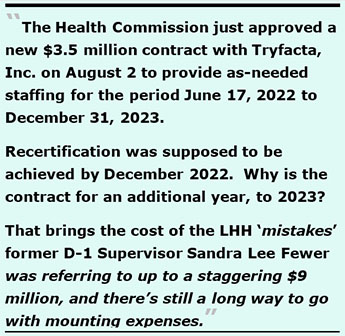 Mounting Costs of Seeking Recertification for LHH Back in May the Health Commission announced it was hiring two consulting firms to assist with ensuring LHH would be able to pass its re-certification inspections with the Centers for Medicare and Medicaid Services (CMS) and with the California Department of Public Health (CDPH). Health Management Associates was hired for a $3.78 million contract, and Health Services Advisory Group, Inc. was hired for a $1.78 million contract.
Mounting Costs of Seeking Recertification for LHH Back in May the Health Commission announced it was hiring two consulting firms to assist with ensuring LHH would be able to pass its re-certification inspections with the Centers for Medicare and Medicaid Services (CMS) and with the California Department of Public Health (CDPH). Health Management Associates was hired for a $3.78 million contract, and Health Services Advisory Group, Inc. was hired for a $1.78 million contract. Laguna Honda Mock Survey Problem Involving “Epic” Database Erupts
As LHH slouches toward filing an application to regain CMS certification in September, the hospital is conducting “mock surveys” designed to mimic an actual reinspection survey conducted by the California Department of Public Health (CDPH).
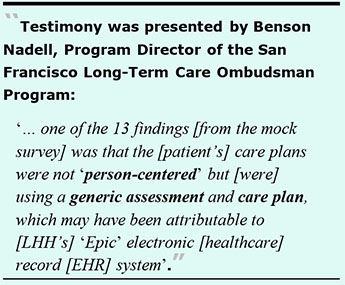 During the LHH-JCC meeting on August 9, Mr. Pickens announced the first mock survey conducted in late June and July had been comprised of two Phases. Results of the second phase showed there had been five areas with findings of high severity in the areas of Infection Control, Environment Free of Hazards, Food Safety, Medical Equipment Maintenance, and Pharmacy Services. That the “Environment Free of Hazards” remains of continuing concern is problematic because many of the citations LHH received between October 2021 and April 14, 2022 had involved citations regarding “hazards” that the City Attorney’s three appeals had disputed.
During the LHH-JCC meeting on August 9, Mr. Pickens announced the first mock survey conducted in late June and July had been comprised of two Phases. Results of the second phase showed there had been five areas with findings of high severity in the areas of Infection Control, Environment Free of Hazards, Food Safety, Medical Equipment Maintenance, and Pharmacy Services. That the “Environment Free of Hazards” remains of continuing concern is problematic because many of the citations LHH received between October 2021 and April 14, 2022 had involved citations regarding “hazards” that the City Attorney’s three appeals had disputed.
Pickens indicated that in preparation for the second mock survey that was scheduled to occur during early August all hospital staff will undergo education and training in the first three weeks of August, and Nursing staff will receive an additional fourth week of training between August 22 and August 28 focusing on developing and documenting “Comprehensive Care Plans” and other “Resident Assessments” and related assessment documentation.
Testimony was presented to San Francisco’s Board of Supervisors on July 26, 2022 by Benson Nadell, Program Director of the San Francisco Long-Term Care Ombudsman Program, which handles oversight of complaints filed on behalf of residents of LHH and other San Francisco nursing homes. Mr. Nadell testified, in part:
“I want to focus on one issue: The kind of paperwork or information package being sent by Laguna Honda [Hospital] to the various receiving nursing homes [patients are being discharged to]. That package of information may be inadequate.
There is no sample available to the Ombudsman’s Office or to anyone outside of Laguna Honda. We’ve received phone calls from family members all the time who have loved ones there [at LHH] who can’t visit [nursing homes] in Burlingame or some of the others [facilities] because of COVID.
I’m homing in on this assessment and care planning process. LHH conducted a mock survey [recently in preparation for a formal re-survey by the California Department of Public Health] and one of the 13 findings [from the mock survey] was that the [patient’s] care plans were not “person-centered” but [were] using a generic assessment and care plan, which may have been attributable to [LHH’s] “Epic” electronic [healthcare] record [EHR] system. I don’t know [for sure]. But if the care plans and assessments are not person-centered, then the information at the receiving nursing home will be only focused on very sandwiched and condensed [care plans], only on the level of care. Also, there is the assumption of an equivalency of one nursing home with another.”
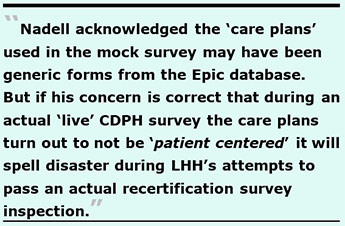 Notably, Nadell acknowledged that the “care plans” used in the mock survey may have been generic forms from the Epic database. But if his concern is correct that during an actual “live” CDPH survey the care plans turn out to not be “patient centered” and not tailored to each patient, this will spell disaster during LHH’s attempts to pass an actual recertification survey inspection.
Notably, Nadell acknowledged that the “care plans” used in the mock survey may have been generic forms from the Epic database. But if his concern is correct that during an actual “live” CDPH survey the care plans turn out to not be “patient centered” and not tailored to each patient, this will spell disaster during LHH’s attempts to pass an actual recertification survey inspection.
I spoke with Blanca Castro, who is California’s Long Term Care Ombudsman and director of the State Long-Term Care Ombudsman Program at the California Department of Aging on August 10, 2022.
Ms. Castro noted that LHH was in the middle of the discharge and transfer process as required by their federal and state approved closure plan, which has been temporarily paused at LHH as of July 28, 2022 at the direction of the Centers for Medicare and Medicaid Services (CMS). She indicated that the state has not indicated yet if, or when, the LHH discharges may resume.
Castro noted all residents of long-term care skilled nursing facilities have the right to request all of their medical assessments and care plans prior to being referred for relocation to another care facility, whether the records are in an electronic healthcare record or in paper-based charts. That includes a wide variety of patient care assessments, not just their physical healthcare assessments.
“If nursing home residents or their families are not being provided with the care plans needed to receive the proper level of care unique to their needs prior to discharge to a different facility, they should work with the Ombudsman assigned to the facility they are currently in to demand they be provided with their medical records to ensure their patient safety. While the care plans are important documentation, there are other assessment forms that should be requested and provided, too.” Castro said.
She added that families should check their loved one’s records and specifically ask for copies of those records if they feel any records may not have been provided to them, since they have the right to request and receive all records, including medical records and all patient assessments conducted.
Mr. Nadell’s program in San Francisco can be reached at 415 751 9788. Ms. Castro’s State program can be contacted at StateOmb@aging.ca.gov.
“Restorative Care” Treatment Problems for LHH Patients Return, Two Decades Later
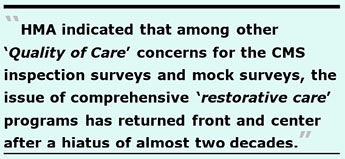 The Westside Observer has learned that Health Managements Associates (HMA) — one of the two consultants hired at a combined cost of $5.6 million to assist SFDPH regain CMS re-certification and avoid LHH’s closure — published an “Initial CMS Recertification Survey Readiness Assessment” on June 13, 2022 in which HMA indicated that among other “Quality of Care” concerns for the CMS inspection surveys and mock surveys, the issue of comprehensive “restorative care” programs has returned front and center after a hiatus of almost two decades.
The Westside Observer has learned that Health Managements Associates (HMA) — one of the two consultants hired at a combined cost of $5.6 million to assist SFDPH regain CMS re-certification and avoid LHH’s closure — published an “Initial CMS Recertification Survey Readiness Assessment” on June 13, 2022 in which HMA indicated that among other “Quality of Care” concerns for the CMS inspection surveys and mock surveys, the issue of comprehensive “restorative care” programs has returned front and center after a hiatus of almost two decades.
HMA wrote, in part:
“Quality of Care concerns exist as a comprehensive resident restorative program has not been implemented, and the activities offered are inadequate given the lack of evening offerings. Nationally, there has been a focus on ensuring appropriate restorative programming and activities have been implemented as a lack of limited programming and interaction during the COVID-19 pandemic has driven a noted decline in functions in SNF residents.”
HMA was wrong. The reduction of restorative care offerings at LHH was not due solely to COVID, which came along in 2020. LHH’s restorative care programming vanished in approximately 2013. What HMA may not know, or may not have historical knowledge of, is that a robust restorative care program had been rolled out and implemented at LHH, as early as 2004 and then updated in 2009.
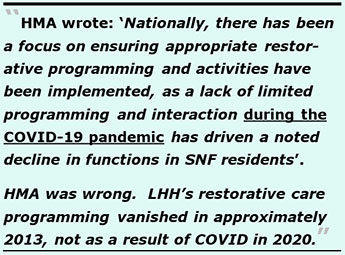 In early May 1998, the U.S. Attorney General’s Civil Rights Division had written to then-San Francisco Mayor Willie L. Brown (which is still available on the Internet) and had courtesy copied then-City Attorney Louise Renne the letter noting:
In early May 1998, the U.S. Attorney General’s Civil Rights Division had written to then-San Francisco Mayor Willie L. Brown (which is still available on the Internet) and had courtesy copied then-City Attorney Louise Renne the letter noting:
“… that nursing home residents have the right to receive care and services necessary to ‘attain or maintain the highest practicable physical, mental, and psychosocial well-being.’ These services include ‘specialized rehabilitative services,’ such as physical, occupational and speech therapy, as well as recreational and stimulating activities.
… Similarly, the lack of adequate physical therapy services in a nursing home setting typically results in more residents losing functional abilities, resulting in residents being confined to their wheelchairs or beds due to a deterioration of their physical abilities and overall health.
A major reason for the failure to provide adequate speech, occupational, and physical therapy services appears to be the lack of staffing. Due to inadequate numbers of staff, the therapy staff serve more in a consultant role than as actual members of the interdisciplinary team. Therapy staff rely exclusively on referrals from the in-house staff or family members. According to discussions with therapy staff, they develop a therapy program for a resident, provide some staff training, and then rely on the nursing staff to implement the program.
There also is a lack of sufficient resident activities at LHH, in violation of the federal statutory rights of nursing home residents. … LHH's Director of Activities agrees that there are insufficient activity staff to provide adequate stimulation and activities for LHH residents …
LHH is not meeting the specialized rehabilitative therapy and activity needs of its residents. As a result, the facility is not helping residents attain their highest practicable physical, mental, and psychosocial well-being, as required, and residents suffer an increased risk of morbidity, mortality and deterioration.”
While HMA may be correct that LHH is not currently offering sufficient restorative care programming and services, and while the U.S. Department of Justice had been right noting that LHH at one point LHH wasn’t offering specialized restorative therapies, it wasn’t always this way.
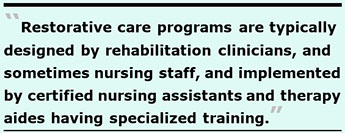 Restorative care involves optimizing and maintaining a patient’s physical, mental, and psychosocial functioning, and determines the extent to which a resident of a skilled nursing facility should receive rehabilitation or and restorative services. Restorative care programs are typically designed by rehabilitation clinicians, and sometimes nursing staff, and are implemented by certified nursing assistants and therapy aides having specialized training. The collaborative implementation of restorative care services is designed to increase the chances for nursing home residents to improve or maintain their functional abilities.
Restorative care involves optimizing and maintaining a patient’s physical, mental, and psychosocial functioning, and determines the extent to which a resident of a skilled nursing facility should receive rehabilitation or and restorative services. Restorative care programs are typically designed by rehabilitation clinicians, and sometimes nursing staff, and are implemented by certified nursing assistants and therapy aides having specialized training. The collaborative implementation of restorative care services is designed to increase the chances for nursing home residents to improve or maintain their functional abilities.
I was hired at LHH in 1998 to support three new senior rehabilitation clinicians in Physical Therapy, Occupational Therapy, and Speech Pathology. Our team of four set about hiring both additional rehabilitation clinicians (people with master’s degrees in their specialties), and hiring four Restorative Therapy Aides — Certified Nursing Assistants who had skills and training in restorative care therapy techniques who were supervised by Rehabilitation Clinicians. The Restorative Care program grew quickly, and eventually we satisfied the U.S. Department of Justice we were helping patients regain and maintain their functional abilities; the program was a success and soon we were getting many regular referrals from hospital physicians who noted our programs were having a positive affect on residents.
To implement our restorative care program, we had to seek approval and authorization from the chairperson of the LHH Policy and Procedure Committee, the Executive Administrator of LHH, and the Director of the San Francisco Department of Public Health. Those who signed off on the Restorative Care – Level I program included Dr. Lisa Pascual, Chief of LHH’s Rehabilitation Services Department; Dr. Hosea Thomas, LHH’s then-Interim Medical Director; Mivic Hirose, LHH’s then Executive Administrator; and Dr. Mitchell Katz, then the director of the Department of Public Health. They all enthusiastically supported our program.
Our restorative care program had two levels:
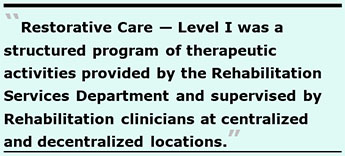 Restorative Care — Level I: The Level I program, was a structured program of therapeutic activities provided by the Rehabilitation Services Department and supervised by Rehabilitation clinicians. Level I care was provided by therapy staff at centralized and decentralized locations. In general, Level I care was indicated in situations where the program required specialized equipment or therapeutic physical approaches that were of sufficient complexity that they could not be easily performed by Unit Nursing staff [on wards or in neighborhoods.].
Restorative Care — Level I: The Level I program, was a structured program of therapeutic activities provided by the Rehabilitation Services Department and supervised by Rehabilitation clinicians. Level I care was provided by therapy staff at centralized and decentralized locations. In general, Level I care was indicated in situations where the program required specialized equipment or therapeutic physical approaches that were of sufficient complexity that they could not be easily performed by Unit Nursing staff [on wards or in neighborhoods.].
LHH physicians could request one or more types of restorative care modalities for their patients depending on resident needs, including Gait/Exercise, Activities of Daily Living, Upper-Extremity Exercise, Tone Management, and Range of Motion, all tailored to the level of care a given resident required.
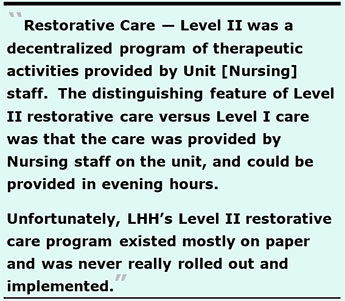 The Level I program was held in a treatment gym outside of the main swimming pool in the replacement hospital. It was the perfect spot in a gym separate from the main physical therapy and occupational therapy treatment areas, giving restorative care patients a unique and quieter space to regain functional independence.
The Level I program was held in a treatment gym outside of the main swimming pool in the replacement hospital. It was the perfect spot in a gym separate from the main physical therapy and occupational therapy treatment areas, giving restorative care patients a unique and quieter space to regain functional independence.
Restorative Care — Level II was a decentralized program of therapeutic activities provided by Unit [Nursing] staff, by physician referral. The distinguishing feature of Level II restorative care versus Level I restorative care was that the care was provided by Nursing staff on the unit.
One idea was that the unit-based care could be provided in evening hours; rehabilitation staff typically worked 9:00 a.m. to 5:00 p.m.
Unfortunately, the Level II restorative care program existed mostly on paper and was never really rolled out and implemented, in part given constraints on unit Nursing staff. One result of not implementing the Restorative Care — Level II program was that the hope of implementing restorative care evening hours to augment programs done by Activity Therapy Department staff flew out the window and never returned.
The Center Did Not Hold
Although the Restorative Care — Level I program had a lot going for it, it couldn’t withstand LHH’s Nursing Department, which was a hotbed of intrigue. The center of LHH’s restorative care program could not hold, and the program vanished into the night.
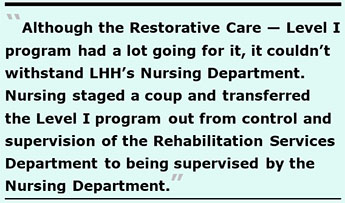 Within two years of moving into the replacement hospital in 2010, the Nursing Department staged a coup and transferred the Restorative Care – Level I program out from under the control and supervision of the Rehabilitation Services Department to being supervised by the Nursing Department. The four Restorative Care Therapy Aides were known until that time as “Physical Therapy Aides” by formal job classification code and job classification name in the City Controller’s payroll database. Their formal job classification name was subsequently changed to just “Therapy Aide.” And until then, it was a requirement they receive direct supervision by a licensed physical therapist or occupational therapist. How the Nursing Department got around the supervision requirement isn’t known.
Within two years of moving into the replacement hospital in 2010, the Nursing Department staged a coup and transferred the Restorative Care – Level I program out from under the control and supervision of the Rehabilitation Services Department to being supervised by the Nursing Department. The four Restorative Care Therapy Aides were known until that time as “Physical Therapy Aides” by formal job classification code and job classification name in the City Controller’s payroll database. Their formal job classification name was subsequently changed to just “Therapy Aide.” And until then, it was a requirement they receive direct supervision by a licensed physical therapist or occupational therapist. How the Nursing Department got around the supervision requirement isn’t known.
Indeed, the cutback in providing restorative care treatments at LHH happened somewhere between 2013 and 2015, approximately five years before COVID came along, so HMA was wildly incorrect attributing it solely to COVID.
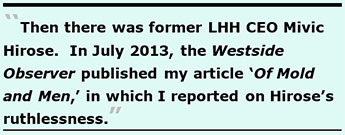 What is known is that the four therapy aides were by report pretty unhappy with their change in supervision, which created quite a hullabaloo surrounding changes to the restorative program, including it being taken over by Nursing and moved out of the specialized treatment gym in the Pavilion building.
What is known is that the four therapy aides were by report pretty unhappy with their change in supervision, which created quite a hullabaloo surrounding changes to the restorative program, including it being taken over by Nursing and moved out of the specialized treatment gym in the Pavilion building.
Then there was former LHH CEO Mivic Hirose.
In July 2013, the Westside Observer published my article “Of Mold and Men,” in which I reported on Hirose’s ruthlessness when it came to LHH employees. I wrote in part:
“Slavin’s disappearance is reminiscent of the hit-job on LHH’s former Chief Operating Officer, Gayling Gee, who had vied with Mivic Hirose for the job as LHH’s Director of Nursing when both women served as Co-Directors.
Within just days of Hirose’s promotion to being LHH’s CEO, and after Ms. Gee spoke out during a Health Commission meeting advocating to save LHH’s Adult Day Health Program, using her First Amendment free-speech rights as a private citizen on her own time — rights for City employees protected by San Francisco’s Sunshine Ordinance — Ms. Gee was told by Hirose on a Friday to get out within 24 hours. [Gee] cleared out her office on Saturday. On Monday, nobody said a word about Gee’s forced ouster, lest word would get back to Mivic. After serving for two decades at LHH, there was no going-away party for Gee — and no thanks for her dedicated services.”
Former LHH physician Victoria Sweet published a book [“God’s Hotel”] in 2012 which used LHH as a backdrop. [I’d recommend it, were it not for the fact that the stories Sweet used to illustrate complex concepts used only aliases for LHH staff, and used not one date to place historical events into context. I dislike the book intensely.]
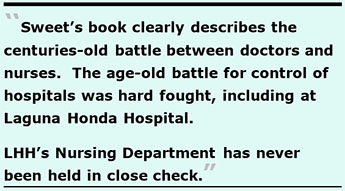 But Sweet’s book clearly describes the centuries-old battle between medicine — doctors, who wanted to control hospitals to correlate medical treatments with patiens outcomes — and nurses — who objected largely on the grounds that patients weren’t “things” to be experimented on. The age-old battle for control of hospitals was hard fought, including at LHH.
But Sweet’s book clearly describes the centuries-old battle between medicine — doctors, who wanted to control hospitals to correlate medical treatments with patiens outcomes — and nurses — who objected largely on the grounds that patients weren’t “things” to be experimented on. The age-old battle for control of hospitals was hard fought, including at LHH.
Sweet acknowledged that the dynamic between the Department of Medicine, the Nursing Department, and Hospital Administration needed to be held in close check to advance optimal patient outcomes.
For over 20 years of my involvement with Laguna Honda, the same battle for control has raged on, but LHH’s Nursing Department has never been held in close check. Just look at LHH’s history of Nursing violations uncovered during CMS and CDPH hospital inspections. It’s hard to argue with the survey results.
Hirose waged much of the battle for control of LHH before she was forced out in 2019 over the patient sexual abuse scandal. [Unfortunately, Hirose is still lurking around as a senior management employee in San Francisco’s Department of Public Health.] Sweet never became involved in trying to stop the transformation of LHH away from its traditional medical model of patient care.
Additional Problems With SFDPH's “Epic” Database
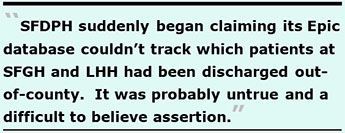 Back in June 2021, I published an initial article on the San Francisco Department of Public Health’s new $164.7 million Electronic Healthcare Records (EHR) database known as “Epic” that was rolled out and went live in August 2019.
Back in June 2021, I published an initial article on the San Francisco Department of Public Health’s new $164.7 million Electronic Healthcare Records (EHR) database known as “Epic” that was rolled out and went live in August 2019.
SFDPH suddenly began claiming its Epic database couldn’t track which patients at SFGH and LHH had been discharged out-of-county. It was probably untrue and a difficult to believe assertion. I had reminded SFDPH that California’s Public Records Act (CPRA) §6253.9(a)(2) specifically requires local government agencies to extract and produce aggregated, de-identified data from databases the City maintains, such as the Epic database, and not to include HIPAA-protected client-identifying data.
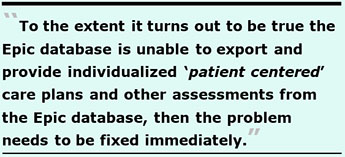 In February 2022, I published a follow-up article on the Epic database reporting on more ridiculous claims SFDPH had made about why the Epic database was incapable of being able to report out-of-county discharges from the two county hospitals.
In February 2022, I published a follow-up article on the Epic database reporting on more ridiculous claims SFDPH had made about why the Epic database was incapable of being able to report out-of-county discharges from the two county hospitals.
First, to the extent it turns out to be true the Epic database is unable to export and provide individualized “patient centered” care plans and other assessments from the Epic database, which would be just as damaging — or even more damaging — than the revelation that Epic is unable to track whether patients are being discharged out-of-county, then the problem needs to be fixed immediately.
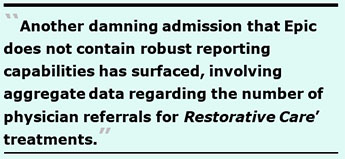 Second, another damning admission that Epic does not contain robust reporting capabilities has surfaced, involving aggregate data regarding the number of physician referrals for referrals for “Restorative Care” treatments in both the Physical Therapy, or PT — (lower body mobility) and the Occupational Therapy, or OT (upper-body mobility) departments.
Second, another damning admission that Epic does not contain robust reporting capabilities has surfaced, involving aggregate data regarding the number of physician referrals for referrals for “Restorative Care” treatments in both the Physical Therapy, or PT — (lower body mobility) and the Occupational Therapy, or OT (upper-body mobility) departments.
On June 20, 2022 the Westside Observer placed a records request to SFDPH asking if LHH’s Medical Records Form #505 — “Physician Order Form/Consultation Request” — was still being used by LHH physicians to order regular PT and OT services, and/or PT and OT specialized restorative care treatments for patients to prevent functional declines, and whether the order form had been tied into the Epic database to submit electronically. DPH’s public records staff responded within two days by providing the forms on June 22 showing that physicians orders for restorative care are submitted on-line in Epic.
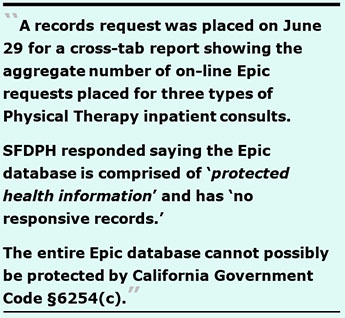 On June 29, I placed a follow-up records request to SFDPH seeking:
On June 29, I placed a follow-up records request to SFDPH seeking:
“A cross-tab report showing the aggregate number of on-line Epic requests placed for three types of Physical Therapy inpatient consult requests — a) Home evaluations, b) Community re-integration, and c) Restorative care program therapies — stratified by calendar year for 2020, 2021, and year-to-date for 2022 after Epic was rolled out and went live in August 2019”
I also requested similar data for the same three services offered for LHH’s Occupational Therapy inpatient consult requests submitted by LHH physicians. SFDPH Public Records staff invoked a ten-day extension and finally responded on July 12, 2022, saying:
Regarding Record Request #22-3790:
“The EPIC database is comprised of protected health information under various protections, including but not limited to 45 CFR Part 160, Part 164 Subparts A & E; Cal. Civil Code Sec. 56.10; and Cal. Govt. Code Sec. 6254(c) and is not a public record. Additionally, no other document or report containing the information you seek exists; thus, there are no responsive documents.”
I don’t know who is feeding DPH Public Records staff the baloney that they don’t have to comply with CPRA §6253.9(a)(2), but they’re wrong. The entire Epic database cannot possibly be protected by California Government Code §6254(c), particularly since a limited amount of aggregate, de-identified physician referrals — that don’t include protected health information about any identifiable patient — had been requested.
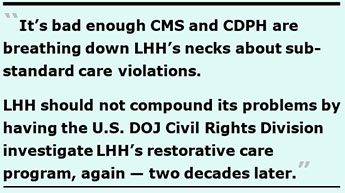 Unless SFDPH reverses course and provides the aggregate, de-identified data about the aggregate number of physician orders submitted tor restorative care treatments provided in the past three fiscal year, and complies with CPRA §6253.9(a)(2) rapidly, this will become the basis for another Sunshine Complaint regarding the Epic database.
Unless SFDPH reverses course and provides the aggregate, de-identified data about the aggregate number of physician orders submitted tor restorative care treatments provided in the past three fiscal year, and complies with CPRA §6253.9(a)(2) rapidly, this will become the basis for another Sunshine Complaint regarding the Epic database.
It’s bad enough CMS and CDPH are breathing down LHH’s necks about substandard care violations and LHH’s Medicare reimbursement. But LHH should not compound its problems by having the U.S. DOJ Civil Rights Division investigate LHH’s restorative care program, again — now two decades later — over not preventing LHH residents’ functional decline.
____________________________________________________________
In HMA’s June 13 Preliminary Readiness Assessment report, it admitted that its principal limitation was that it was unable to access SFDPH’s and LHH’s “Epic” database. Because the CMS/CDPH reinspection survey process is driven by care delivery processes documented in patient’s electronic health records, hopefully HMA’s inability to get into Epic has been solved by now.
Monette-Shaw is a columnist for San Francisco’s Westside Observer newspaper, and a retired City employee. He received a James Madison Freedom of Information Award in the “Advocacy” category from the Society of Professional Journalists–Northern California Chapter in 2012. He’s a member of the California First Amendment Coalition (FAC) and the ACLU. Contact him at monette-shaw@westsideobserver.com.